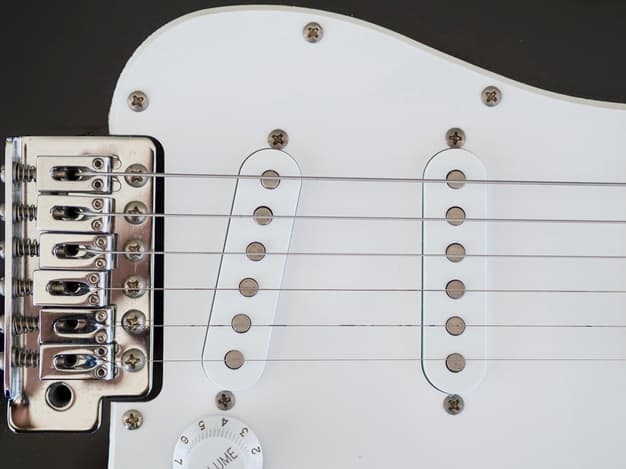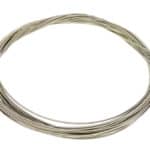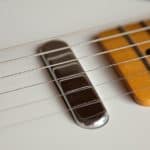“String gauge”
For many new guitar players this concept is yet another in a long list of things they don’t understand.
And just like hearing about diminished chords or the whole tone scale, these foreign concepts can lead to players feeling overwhelmed and confused.
These feelings end up making lots of players worried that they are playing with the wrong string gauge.
There is no such thing as the “wrong string gauge.” All players will have their own personal preference for what feels good for them on their instrument, and for their style of playing. New players should feel free to try different gauges as long as they are properly set up on the instrument.
This is another example of how when it comes to guitar, it really is up to you!
That being said, there are some general guidelines and common practices that you should be aware of.
Here are a few things you should know to help you explore the world of string gauges.
What’s the point of there being different string gauges?
String Gauges (which just refers to the thickness of a string) are used to create different amounts of tension and therefore create different feeling and playability for the guitarist.
Different gauges were created to fit the needs and tastes of different guitarists across all genres.
For example, early blues guitarists liked thin strings that made it easier to bend notes.
In contrast, many guitarists who play heavier music like to use heavier gauge strings.
Heavier gauge strings work better when playing in low tunings because they still allow you to keep a consistent tension and feeling throughout the strings.
Can a different string gauge damage my guitar?
Generally speaking, most string gauges will work fine with any guitar and not damage it.
Bass strings have much too high a gauge to be used on a guitar and so you should not try to fit them on one!
Classical Spanish guitars use nylon strings and do not have the hardware to hold the tension of steel strings of any gauge and so you should not attempt this either!
So, unless you do something extreme (or stupid) the integrity of your instrument won’t be at risk if you experiment with different kinds of strings. The only thing that could happen is that your guitar would become unplayable due to a poor setup.
Will a different string gauge affect your playing?
Yes!
Different string gauges will certainly affect your playing.
The strings will feel different in your hands and require more or less pressure to push them down on the fretboard.
Lighter strings are much easier to bend and players will naturally adjust the amount of force they apply.
Thicker strings will have you inclined to dig in more with your pick and use the force of multiple fingers to bend notes.
Thinner strings will generally let you play faster and with less force.
This influences your tone and style of play.
But are thinner strings better, then? Well, not really. It’s just a matter of taste and play style, as I mentioned earlier.
To each their own.
Is there any problem with changing the string gauge?
When changing string gauge it is important to adjust the setup of your guitar.
Heavier strings put more tension on the neck than lighter ones.
Different amounts of tension can create changes in the string height or action of your guitar.
Adjusting your bridge and truss rod so that you have optimum action and playability is important when trying a new string gauge.
Can I mix and match different string gauges?
You can mix and match strings from different sets of string gauges.
For example, using half the strings from a pack of 10 gauge and half from a 9 gauge pack.
Ernie Ball and other manufacturers actually make hybrid sets that are combinations like this.
Just make sure that your strings are getting thicker as you move up towards the low E string and you don’t use an odd thick or thin string somewhere in the mix.
Can I use a string from a different gauge in my set?
If you break a string from your set and don’t have a match to replace it, it’s ok to use one from a different set.
You may notice the feel being slightly off, which is just because the string is slightly thicker or thinner than the rest of the set.
There may be some fret buzz because the new string is not ideal for your current setup.
In this case, you could adjust the setup to make it more playable.
Or just power through the gig with it and put on a matching set after!
How to know what string gauge works better for you
The best way to know what is best for you is to try for yourself
Don’t pay attention to what others say is the best or tell you you have to use
Generally, most players stick to gauges between 8 and 10 but going above or below or using a mix is cool too!
When it comes to guitar, all the decisions are in the player’s hands.
From the string gauge to the type of instrument, to the notes we play.
Find what you like, and use it to express yourself through music.

Hello there, my name is Ramiro and I’ve been playing guitar for almost 20 years. I’m obsessed with everything gear-related and I thought it might be worth sharing it. From guitars, pedals, amps, and synths to studio gear and production tips, I hope you find what I post here useful, and I’ll try my best to keep it entertaining also.





